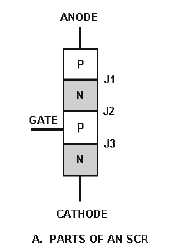3-20
The SCR is an extremely fast switch. It is difficult to cycle a mechanical switch several hundred
times a minute; yet, some SCRs can be switched 25,000 times a second. It takes just microseconds
(millionths of a second) to turn on or off these units. Varying the time that a switch is on as compared to
the time that it is off regulates the amount of power flowing through the switch. Since most devices can
operate on pulses of power (alternating current is a special form of alternating positive and negative
pulse), the SCR can be used readily in control applications. Motor-speed controllers, inverters, remote
switching units, controlled rectifiers, circuit overload protectors, latching relays, and computer logic
circuits all use the SCR.
The SCR is made up of four layers of semiconductor material arranged PNPN. The construction is
shown in view A of figure 3-18. In function, the SCR has much in common with a diode, but the theory
of operation of the SCR is best explained in terms of transistors.
Figure 3-18A.—SCR structure.
Consider the SCR as a transistor pair, one PNP and the other NPN, connected as shown in views B
and C. The anode is attached to the upper P-layer; the cathode, C, is part of the lower N-layer; and the
gate terminal, G, goes to the P-layer of the NPN triode.
Figure 3-18B.—SCR structure.



